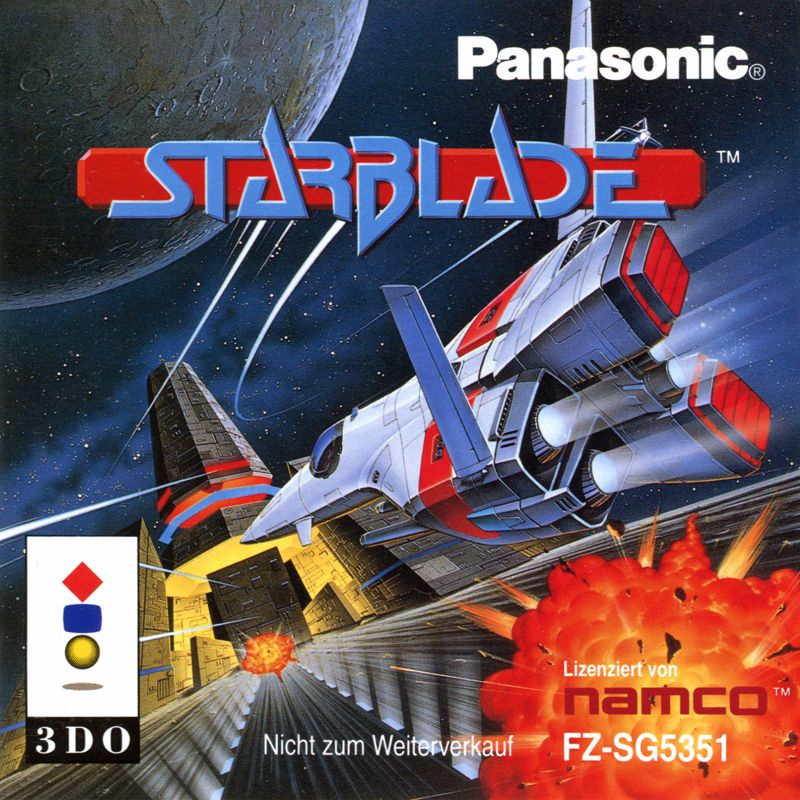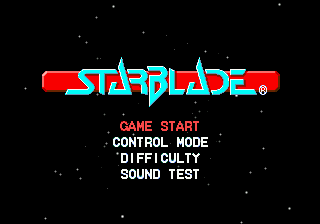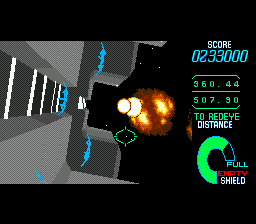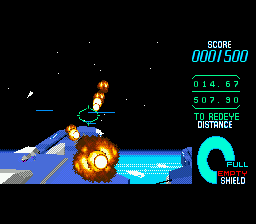Retro Replay Review
Gameplay
Starblade places you in the gunner’s seat of a GeoSword fightercraft on a one-way mission to dismantle the enemy armada and take the fight to the heart of the rebel stronghold, the planet Redeye. From the moment you engage with your first wave of attackers, the emphasis is on raw reflexes and precise shooting. You’ll have roughly ten distinct missions to play through, each escalating in intensity and complexity. As you blast through enemy fighter wings, you’ll feel the heat of incoming fire and the satisfaction of a well-placed shot.
(HEY YOU!! We hope you enjoy! We try not to run ads. So basically, this is a very expensive hobby running this site. Please consider joining us for updates, forums, and more. Network w/ us to make some cash or friends while retro gaming, and you can win some free retro games for posting. Okay, carry on 👍)
Each mission introduces new objectives and environments to keep the action from feeling stale. You’ll be tasked with carving a path through the sides of massive battlecruisers, infiltrating enemy carriers from tight internal corridors, and weaving between towering canyon walls on the surface of Redeye. Your wingmen provide limited support, offering covering fire and tracking targets, but ultimately you’re responsible for delivering the decisive blows that determine the fate of the galaxy.
For players seeking additional replay value, Starblade on PlayStation and 3DO offers both an arcade mode and an enhanced mode. Arcade mode preserves the classic on-rails shooter feel with black bars on each side, mimicking the feel of an arcade cabinet screen. Enhanced mode remaps flat-shaded polygons into fully textured models, removes the black bars for a fullscreen presentation, and often improves draw distance. Control is responsive whether you’re using a standard controller or a light gun peripheral, and each mode feels distinct enough to warrant multiple playthroughs.
Graphics
When Starblade launched, its visual presentation was striking for a home console and CD-based platform. In arcade mode you’re presented with flat-shaded polygons that convey a clean, futuristic aesthetic but admittedly look sparse by modern standards. Switching to enhanced mode unleashes textures on every surface: hull plating on enemy ships takes on a gritty, metallic sheen, canyon walls on Redeye show strata lines and dust particles, and cockpit readouts become more readable and detailed.
Environmental variety is another strength of Starblade’s graphics engine. Battlecruisers loom ominously against starfields, their window slits and gun ports rendered in sharp contrast. Inside carriers, dimly lit corridors are punctuated by flashing warning lights and defensive turrets that track your every move. On Redeye’s surface, craggy canyons stretch into the distance, complete with swirling dust clouds and rock formations that create a true sense of depth, especially in enhanced mode’s widescreen presentation.
Performance-wise, both PlayStation and 3DO versions maintain a steady frame rate, even during the most chaotic dogfights and explosions. Load times between missions are modest thanks to the CD-ROM format, and texture pop-in is minimal. While purists might prefer the raw clarity of flat polygons, most players will appreciate the richer palettes and fuller field of view offered in enhanced mode. Whether you value nostalgia or want the crispest images possible, Starblade delivers a consistently impressive visual experience.
Story
Starblade’s narrative is straightforward but effective: the galaxy is under threat from the Redeye rebels, and you’re the pilot tasked with neutralizing their armada before they can invade the Federation’s homeworlds. Briefings before each mission outline your objectives clearly, setting up new targets and strategic points of interest. Dialogue is sparse but purposeful, delivered through text overlays and occasional voiceovers that punctuate mission start and end sequences.
Although the plot doesn’t venture into deep character arcs or moral quandaries, it provides ample motivation for the nonstop action. Each mission builds upon the last, with escalating stakes that culminate in a final assault on Redeye’s core defenses. Your wingmen—named pilots with minimal backstory—offer quick radio chatter that adds personality to the proceedings and keeps you loosely tethered to a larger squad dynamic. The story progression feels satisfying as you move from space skirmishes into the planet’s canyons, demonstrating a clear sense of escalation.
Cutscenes are brief but well-timed, using pre-rendered sequences or engine-generated flybys to transition between mission locales. There’s enough narrative framing to make each level feel purposeful, even if the dialogue can be cliché at times. For a rail-shooter, the emphasis is rightly placed on action, but Starblade’s lean storytelling does just enough to keep players invested in the outcome of each battle.
Overall Experience
Starblade excels as a classic on-rails shooter that balances high-octane action with visual flair. Its tight pacing ensures you’re never waiting around for enemies to appear, and each mission introduces new threats and environments to maintain excitement. The dual-mode presentation on home consoles gives players agency over their preferred experience: go for the retro charm of arcade mode or immerse yourself in the richer, full-screen textures of enhanced mode.
While the on-rails structure limits exploration, it also delivers a focused, adrenaline-fueled ride that few games in the genre can match. If you’re a fan of arcade-style shooters or nostalgic for mid-’90s polygonal graphics, Starblade offers hours of satisfying gameplay. The variety in mission design—from dogfights in open space to canyon runs and carrier infiltrations—ensures that no two levels feel identical.
Ultimately, Starblade stands the test of time as a showcase for what rail-based shooters can achieve on home systems. Its straightforward storyline provides just enough context to keep you engaged, and its presentation—especially in enhanced mode—still looks impressive decades later. Whether you’re new to the genre or a seasoned veteran, this title is well worth your time and offers a compelling challenge that will have you returning for multiple runs.
 Retro Replay Retro Replay gaming reviews, news, emulation, geek stuff and more!
Retro Replay Retro Replay gaming reviews, news, emulation, geek stuff and more!









Reviews
There are no reviews yet.